Understanding Buoyancy Using Archimedes’s Principle
Archimedes’ principle states that for a body wholly or partially immersed in a fluid, the upward buoyant force acting on the body is equal to the weight of the fluid it displaces.
Figure shows an object wholly immersed in a liquid. According to Archimedes’ principle:
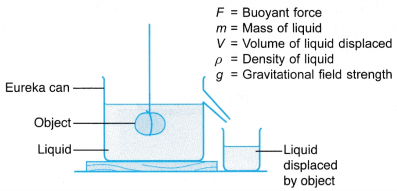
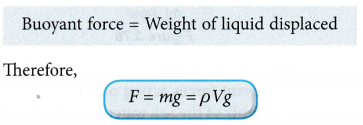
Buoyancy of Objects

Figure shows four situations of objects in a liquid and will be used in the following discussion.
- Figure (a) shows an object whose weight is smaller than the buoyant force. There is a net upward force acting on the object. Thus the object rises up.

- Figure (b) shows an object whose weight is bigger than the buoyant force. There is a net downward force acting on the object. Thus the object sinks.
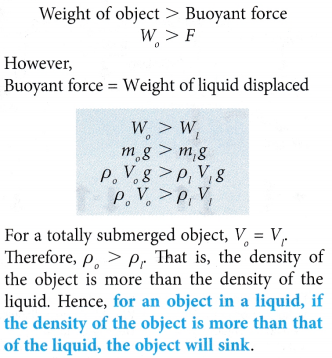
- Figure (c) shows an object whose weight is equal to the buoyant force. The net force acting on the object is zero. Thus the object floats.
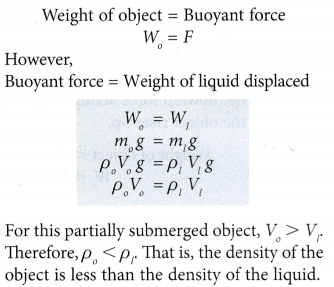
- Figure (d) shows an object whose weight is equal to the buoyant force. The net force acting on the object is zero. Thus the object floats.
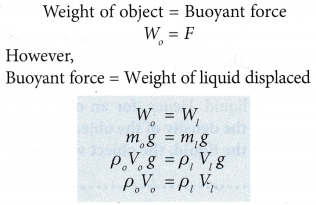

Applications of Archimedes’ Principle
Submarine


- Figure (b) shows how a submarine dives and rises, which can be explained by applying Archimedes’ principle.
- When the ballast tanks of a submarine are filled with water, the weight of the submarine becomes greater than the buoyant force. So, the submarine dives into the sea.
- When compressed air is forced into the ballast tanks purging the water from them, the weight of the submarine becomes less than the buoyant force. So, the submarine rises.
Hydrometer

- Figure shows how a hydrometer works based on Archimedes’ principle.
- The higher the density of a liquid measured, the more the hydrometer floats (or the less the hydrometer submerges).
- The hydrometer can be calibrated to measure the density of a liquid directly.
Hot air balloon

- A hot air balloon displaces a large volume of air.
- Hot air has a lower density than the surrounding air.
- When the buoyant force is greater than the total weight of the balloon, the balloon will rise.
Airship

- An airship is filled with helium, a gas with lower density than the surrounding air.
- Because a large volume of air is displaced by the airship, a big buoyant force is created.
- When the buoyant force is greater than the total weight of the airship, the airship will rise.
Archimedes Principle Example Problems with Solutions
Example 1. A concrete slab weighs 150 N. When it is fully submerged under the sea, its apparent weight is 102 N. Calculate the density of the sea water if the volume of the sea water displaced by the concrete slab is 4800 cm3, [g = 9.8 N kg-1]
Solution:
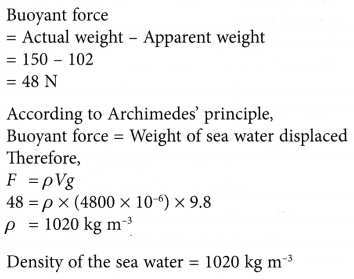
Example 2. A fishing boat sails from sea into a river. Figures (a) and (b) show when it is on the sea and on the river respectively.
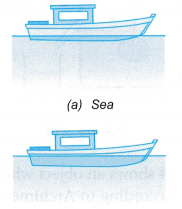
From Figure, compare
(a) the buoyant forces acting on the boat,
(b) the weights of the sea water and the river water displaced by the boat,
(c) the densities of the sea water and the river water.
Solution:
(a) For a floating object, the weight of the object is equal to the buoyant force acting on it. Since it is the same boat for both cases, therefore the buoyant forces acting on the boat are the same.
(b) Since the buoyant force is equal to the weight of the water displaced, therefore the weight of sea water displaced is equal to the weight of river water displaced.
(c) As the weight of sea water displaced is equal to the weight of river water displaced,
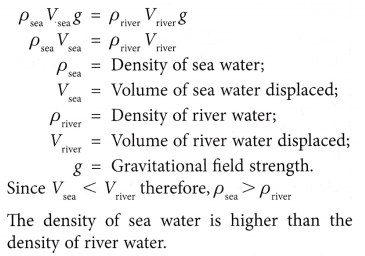
Example 3. Figure shows a boat loaded with some goods floating on a sea. The density of the sea is 1020 kg-3.

(a) Calculate the weight of the boat.
(b) Figure shows the situation of maximum loading of the boat.

Calculate the additional weight of goods that has to be added to the boat to reach this situation.
Solution:
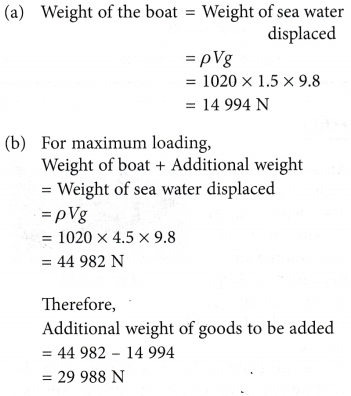
Example 4. A few balloons, which are filled with helium gas, are tied to a brick by a string.

Explain why when the string is cut, the balloons rise.
Solution:
Helium has a lower density than the surrounding air which the balloons displace. When the string is cut, the buoyant force acting on the balloons is now more than the total weight of the balloons. As a result, a net upward force pushes the balloons upward.
